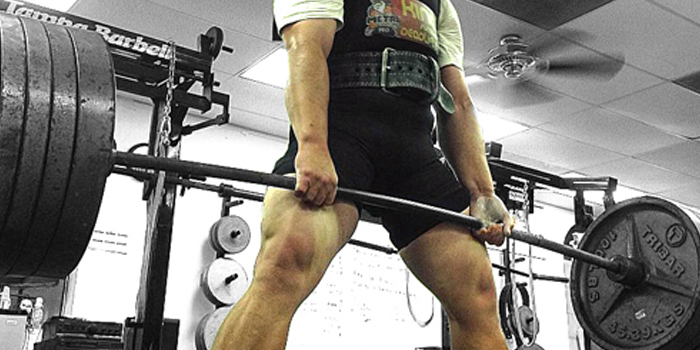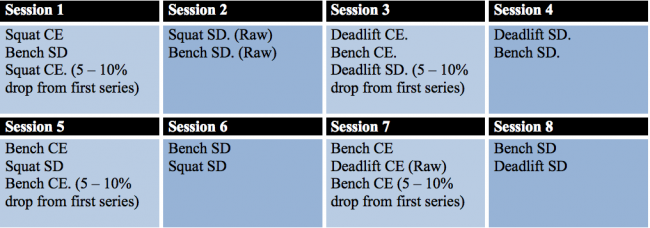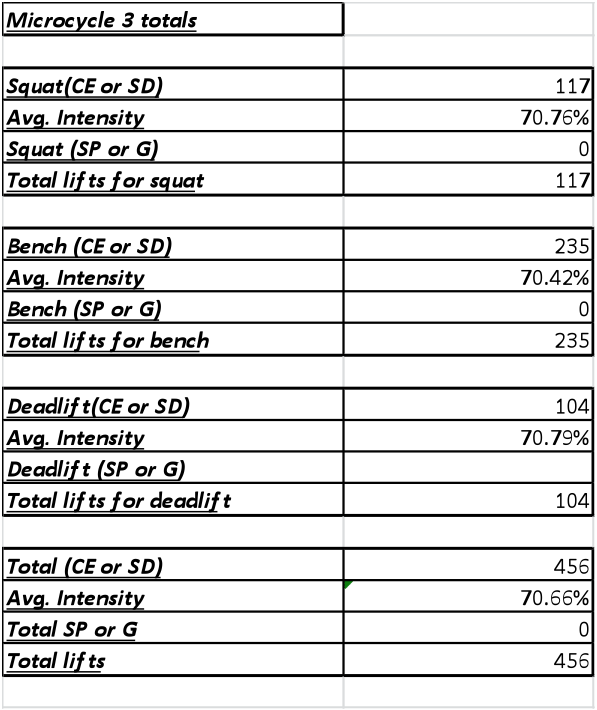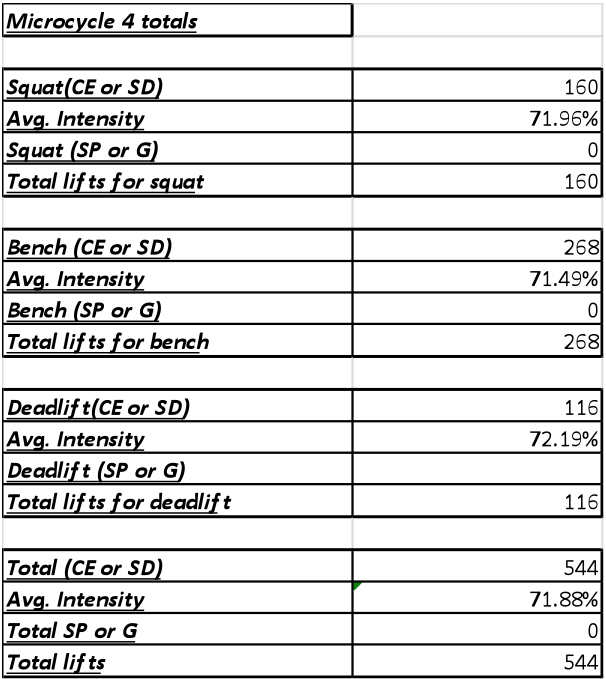
A few articles back, I wrote an article about utilizing a training system with 14-day microcycles as opposed to a traditional seven-day microcycle (known to most as “weeks”) with rotating emphasis between the squat and the deadlift and the bench press emphasized on the separate weeks. I've been piloting this system on myself as well as one of the lifters I coach via the internet. Overall, both of us have noted positive results in both the amount of weight lifted as well as the amount of work that can be tolerated in each session. In this article, I'll discuss why this has been successful and provide some food for thought in implementing this system.
Basic Setup Revisited
There are a few differences between the system that I use and the one that the lifter I coach uses. With mine, the loading is more distributed throughout the week with a concentration on squatting in the former half and a concentration on deadlifting in the latter half. In general, my system looks one of four ways. The first is the preparatory period.
While I compete geared and will do so in July, all my lifting is raw for the time being because I have been using this system since February and have been focused on bringing up my raw lifts. I initially started with the following in preparatory periods, with the second movement of each day based off the percentage and RPE of the first movement. I did this because this was a specialized exercise that was being used to focus on a certain range of the lift but featured the same structure. It was also time efficient to move directly into it, as it required little warm ups if any. This structure was repeated for two microcycles and lasted about a month (four weeks).

For the second block, the following microcycle was used to simulate a transmutative period:

I chose to use the Sheiko-esque “sandwich” style of setting this up because I wanted to use the same movement twice in one session but separated by a break. I also did this to accumulate volume in the actual competitive lifts, both through the second exposure to the movement in the session and also by choosing to warm up again. In this case, I broke all the way down to 50 percent, warmed back up to the desired percentage and performed work sets that fit into the parameters planned. On the first microcycle, I used RPE to govern and shut down all work. On the second microcycle, I attempted to accumulate volume at the desired top weights. The intensity stayed constant, but by increasing the amount of work at the heaviest percentages, the average intensity for not only each individual lift but the entire training block increased. This was also the case for the first block.
To provide an alternate setup, I'll show what we used for my online coaching client. He had expressed scheduling concerns about having limited time on weekdays to train but more time in the latter part of the week to perform more work in each session. Due to this, we still used the rotating emphasis and a 14-day microcycle but had all his specialized movements performed early in the week with the competitive movements performed in the latter part of the week.
This was a block with a greater amount of variety and volume, as this was preparatory in nature. This block was used to begin a gradual transition into greater resemblance to the competitive exercises. With the bench press, we used a larger complex of exercises along with some preparatory work that wasn't used for the squat and deadlift. The squat and deadlift included only competitive and developmental variants. This lasted 28 days, with a total of 16 sessions spread through two microcycles (four per seven-day period). For this block, we used the following exercises:
Squat
- Competitive stance squat (CE)
- Low box squat (SD)
Deadlift
- Sumo deadlift (CE)
- Sumo deficit deadlift (SD)
Bench
- Bench press (CE)
- Bench press with chains (sessions 4 and 8), close grip bench press [session 1 (SD)]
- Incline bench press [session 2 (SP)]

Following this microcycle, we raised the intensity and gradually lowered the volume. This led to a single microcycle of higher intensity and moderate volume. This was a period of fourteen days, with eight sessions of the following exercises:
Squat
- Competitive stance squat [sessions 4 and 8 (CE)]
- Low box squat [sessions 2 and 6 (SD)]
Deadlift
- Sumo deadlift [sessions 3 and 7 CE)]
- Sumo deficit deadlift [sessions 1 and 5 (SD)]
Bench
- Bench press [sessions 3 and 7 (CE)]
- Bench press with chains (sessions 4 and 8), close grip bench press (session 1), floor press [session 2 (SD)]

As shown, the volume is lower due to the “sandwich” sessions being removed and each movement only trained once per session. However, the intensity was raised during this period. Following this, a brief tapering microcycle of fourteen days with six sessions was performed. During this period, only competitive exercises were performed with general exercises used as active rest. Following the completion of this training, the lifter yielded personal records of 20 pounds on the squat, 15 pounds on the bench and 25 pounds on the deadlift for a total PR of 60 pounds. This was after 12 weeks of training and coming off a meet just before that. The 14-day microcycles were used for the final 10 weeks of this plan with the first two weeks following a brief phase of two, seven-day microcycles in the beginning.
Why This Worked
When looking at these models, in each microcycle, there is a period of concentrated loading of a particular movement or movements (i.e. first seven days are loaded heavily with squatting and deadlifting and then the second seven days are loaded heavily with benching) prior to returning to the initial concentration of the first load being repeated during the second microcycle. This creates an initial drop in performance that may be displayed during a week of lower loading. However, the decreased loading allows for a period of supercompensation and an increased level of performance in the second microcycle of each block. Both the lifter who had used this program and I had displayed a much greater amount of volume at the same or even slightly higher percentages during the second microcycle of each block and easily performed more work at the tops sets of each session.
The other thing this allowed us to do was figure out what volumes and intensities work best for each lift. While my average intensities were around 70–72 percent for each lift, the number of lifts broke down as follows for the two microcycles in a four-week mesocycle:
During this block, I was mainly focused only on CE and SD movements. When looking at the numbers, my squatting volume of 117 lifts represented roughly 26 percent of the total volume. My benching volume of 235 lifts represented roughly 52 percent of the volume, and my deadlifting of 104 lifts represented 22 percent of the total lifts. However, in the second microcycle, I progressed as follows:
I pushed the intensity on my deadlift but pushed the volume on my squat and bench. I have found that those lifts respond better to more work whereas my deadlift responds better to slightly higher intensities but less work. When looking at these numbers, squatting accounted for roughly 29.4 percent of the volume (160/544), benching accounted for roughly 49.3 percent of the volume (268/544) and deadlifting accounted for roughly 21.3 percent of the volume (116/544). In this case, my bench has been trained with the lightest percentages but the most volume. I may need to reconsider whether or not this is efficient and whether or not I need to lower my training max or if an approach with higher intensity and less volume should be considered. However, I've responded particularly well to this and will most likely continue with this path to see how it pans out.
Conclusion
On the surface, the initial reason for switching to this style of programming for both myself and the lifter I coach was due to time constraints. Additionally, other reasons could include recovery, availability to gyms with equipment/spotters/training partners and so on. After realizing that we were on to something, I decided to consider the response and what could be behind the success that we were seeing. When using any type of programming, figuring out how and why something works can possibly influence future protocols and help assess the effectiveness of the system.













When in doubt about rep/set schemes look to prelipan's chart.